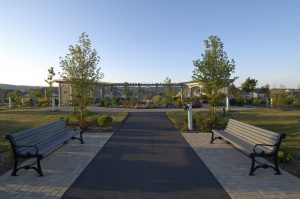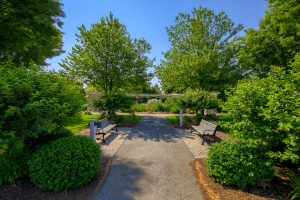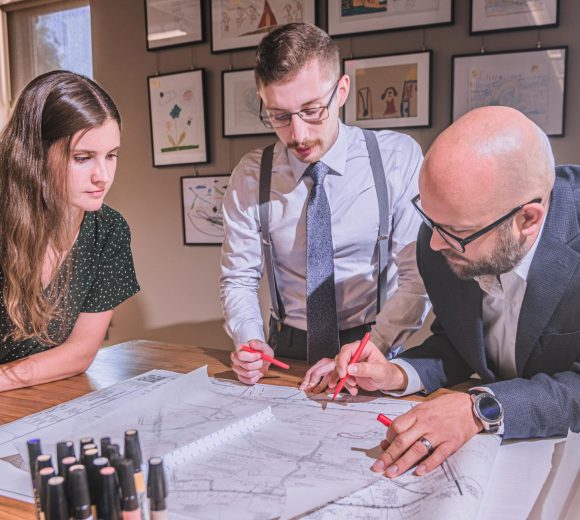Designing Tomorrow’s Landscapes: Managing the Growth and Evolution of Spaces Through Planting Design

For a Landscape Architect, possessing the power of foresight is a job requirement.
In other design professions, the built environment is shaped by concrete, glass, brick, or any number of seemingly static materials. But for landscape architects, their spaces never stand still.
Landscapes and the trees and plants that define them grow, evolve, and mature with every season. These incremental changes mean that the landscape architect’s original plant design isn’t fixed; it must anticipate growth and evolve right along with the plants and trees found in it.
Landscape architects must be able to look 10, 20, or even 30 years into the future to understand how the young landscape they are designing will mature over time. And how that landscape will be enjoyed, utilized, and later perhaps renovated.
Whether they are designing a landscape to manage erosion on a commercial retail site or evoking nostalgia in a memorial garden at a retirement community, landscape architects create a design of plants, trees, and shrubs that, together, form an appropriate, long-living pallet of landscape material.
And the first step of that process is to understand what the client hopes to achieve.
A Landscape’s Design Begins at the Convergence of Client Goals and Project Budgets
Some clients want their landscape to look mature on day one, and they have the budget to speed up the maturation process. Others either don’t have the budget for more mature plants or are less concerned with the instant gratification that comes with a mature landscape.
“Budget dictates landscape approach,” said Bern Panzak, RLA, ASLA, LEED AP, and Principal at Glackin Thomas Panzak, an RGS company. “If a client wants to walk outside and see their newly designed landscape transformed into a lush, shaded greenspace overnight, achieving that instant impact requires the purchase of bigger plants – and that naturally would require a bigger budget.”
But not always. This is where the client’s goals become most critical.


“Let’s say the client is a homebuilder,” Bern said. “Often, builders sell homes out of a temporary sales center located on-site, and of course they want the landscape around the sales center to look appealing to buyers. By choosing large, budget conscious, fast-growing plants, we can provide our client instant impact with a more mature landscape. But as with everything, there’s always a trade-off.”
That trade-off comes in the form of plant longevity and future size appropriateness. But because our builder clients are mainly concerned with the landscape’s effectiveness for 2-3 years or until all homes are sold, it’s typically a trade worth making.
“If a client wants big trees and shrubs planted in a new landscape at a low cost, we can make that happen. But it will typically result in a landscape that may require future renovation earlier than one might expect than if more appropriate, perhaps smaller, slower growing trees and shrubs were to be utilized for the same planting budget. For builders with sales centers who may only want landscapes with a short time horizon, it tends to be an easy choice.”
On the other hand, if a client wants to implement a design with the intention that the tree and shrub features become more permanent fixtures of the property decades into the future, choosing plants with slow and steady growth rates will always be the best choice.
“It’s been my experience that faster-growing plants, by their nature, are structurally weaker over time compared to slower-growing plants,” Bern explained. “What you gain in growth rate early on, you may lose in strength and long-term health.”
Every Plant is Picked for a Purpose
Understanding which plants will help each client reach their landscaping goals is the job of Jennie Ryan-Gisewhite, Registered Senior Landscape Architect at Glackin Thomas Panzak, an RGS company.
“Every landscape has a shelf life,” Jennie said. “The plants we choose for our landscapes are selected based on how they look today as well as how they’ll look down the road. We also think through how each plant will look within the rest of the landscape, so we’re creating spaces that grow together in harmony over time.”


Even with a lot of maintenance, a master plan design will need a landscape renovation about every 15 years.
“When we’re first picking plants, we want to get the big pieces right,” Jennie said. “If you can get the big trees and shrubs in the right spot with enough space to mature out, you can then choose the right plants to fill in the gaps and complete the space. It’s those big trees and shrubs that we’re thinking about when we’re looking ahead at how we imagine the landscape will look 15 years down the road.”
Plant Design is a Balancing Act
Every landscape is a collision of multiple micro-climates – and those climates are always shifting. As a young tree grows and matures, for instance, the ground below it becomes more shaded over time, shifting the landscape from partial sun to full shade. And uprooting any plans the landscape designer may have originally had to carpet the space with sun loving flowering perennials.
“When we’re planning a landscape, we must balance the size of the plants today with how much space they’ll take up in the garden later – and how their growth will impact the growth and health of the plants around them. It’s a balancing act,” Jennie said.


Here in Central and Southeastern PA, RGS’ landscape architects must also balance each landscape’s needs based on seasonal changes.
“We usually want to balance evergreen trees and shrubs that will stay green all year with a variety of flowering plants, so we keep gardens blooming from spring through fall,” Jennie said.
Designing a Low-Maintenance Landscape
Beyond budget and maturation, our team looks for ways that plants can act as tools to support and even protect the surrounding environment. In most cases, this involves low-maintenance plants that add both beauty and function to the space.
“Choosing plants that need less irrigation is an increasing focus for our designers,” Bern said. “We want to pair landscapes with plants that thrive in our climate. That means we must understand moisture needs, natural water sources, shade, and sun patterns, and how these factors work together.” In most cases, native species are uniquely qualified to adapt to these local conditions.


Maintenance during the winter months, when many landscapes are dormant, is an equally important consideration.
“We also have to think through winter weather conditions,” Bern added. “Where will snow removal crews pile snow in the winter? What is each plant’s salt tolerance? Are plants protected from harsh storms? Low maintenance landscapes must be resilient enough to bounce back after a long winter.”
Plants are also incredible tools for rainwater management, preventing erosion, and stormwater management.
“Drainage puts a lot of pressure on landscapes,” Bern said. “Plants can work with other landscape features such as rocks and stones to dissipate flowing water energy and help resist erosion. Some plants lend themselves to this type of work. For example, we’ll often use Iris, Rush, and varieties of grasses.”
For Maturation to Occur, Planting Designers Require Awareness of climate conditions and other natural pitfalls affecting each landscape.
The art and science of planting design are put to the test in places like Central PA and the Philadelphia region, where it’s common to find the perfect combination of conditions for plant stress: Extremes of heat and cold, prolonged periods of drought, dry shade, and deer.
“Deer are an issue that impacts nearly every landscape we design,” Bern said. “We do our best to work with plant material that deer don’t like to eat, but sometimes they surprise us.”
Unfortunately, deer and humans find many of the same plants appealing.
“Hostas are a popular request from our clients,” Bern said. “The problem is that deer love hostas, too. So, we’ll recommend Hakone grass or other similar species as a substitute because they offer similar attributes in color, texture, and size. We may also recommend Lady’s Mantel or ferns, all options that deer typically don’t care to eat. There’s always another option.”
Guiding clients to remove invasive species and replace them with native plants is another way RGS helps clients protect and preserve their landscapes.
“Native plants usually require less maintenance, and they work with the surrounding landscape – not against it,” Jennie said. “Knowing which natives to incorporate into a landscape goes hand-in-hand with understanding micro-environments. Purple coneflower, butterfly milkweed, black-eye Susan – we know these natives will succeed in sunny, drier areas and will add beauty and diversity to our environment.”
Bring Plant Design to Life in Your Landscape – Now and in the Future
When you’re ready to discuss your landscape design goals, contact RGS. Our Landscape Architects are here to understand your landscape needs




